Study on the Interaction Mechanism between Micropiles and Soil Landslides
Abstract
:1. Introduction
2. Introduction to the Test Protocol
2.1. Model Similar Design
2.2. Test Materials and Production Process
2.2.1. Landslide Soil
2.2.2. Testing the Micropiles and Landslide Model-Making Process
2.2.3. Monitoring Programs
3. Pile–Soil Interaction Test Analysis
3.1. Analysis of Destructive Phenomena
3.2. Displacement Data Analysis
3.3. Earth Pressure Data Analysis
3.4. Analysis of Internal Force Data
4. Numerical Simulation Study of Static Forces
4.1. Models and Parameters
- (1)
- The establishment of the static load test model is described in this paragraph.
- (2)
- The values of the simulation parameters are as follows.
- (3)
- Calculation criteria
- (4)
- Measurement point arrangement
4.2. Displacement Data Analysis
4.3. Earth Pressure Data Analysis
4.4. Analysis of Internal Force Data
5. Discussion
5.1. Obvious Sharing Effect of Landslide Thrusts
5.2. Obvious Phase Characteristics of the Force Mechanism
6. Conclusions
Author Contributions
Funding
Institutional Review Board Statement
Informed Consent Statement
Data Availability Statement
Acknowledgments
Conflicts of Interest
References
- Yongqiang, X. The “8.12” landslide in Shanyang County, Shaanxi Province. Chin. J. Geol. Hazards Prev. 2015, 3, 25. [Google Scholar]
- Lihua, W. “11–13” Zhejiang Lishui major landslide disaster relief log. China Disaster Reduct. 2015, 23, 52–53. [Google Scholar]
- Bruce, D.A.; Dimillio, A.F.; Juran, I. A Primer on Micro-piles. Civ. Eng. 1995, 12, 51–54. [Google Scholar]
- Macklin, P.R.; Berger, D.; Zietlow, W.; Herring, W.; Cullen, J. Case history: Micro-pile use for temporary excavation support. In Proceedings of the Sessions of the Geosupport Confenrence: Innovation and Cooperation in Geo, Orlando, FL, USA, 29–31 January 2004; Geotechnical Special Publication. ASCE: Reston, VA, USA, 2004. [Google Scholar]
- Zhang, S.J. The Introduction of Micro-Pile in Building Heightening and Transformation. Adv. Mater. Res. 2014, 3226, 941–944. [Google Scholar] [CrossRef]
- Lee, T.H.; Chul, I.J.; Kim, C. A Method for Reinforcing the Ground Adjacent to the Footing Using Micropiles. Mar. Georesour. Geotechnol. 2016, 34, 341–355. [Google Scholar] [CrossRef]
- Hu, T.F.; Wang, T.L. Numerical Investigation of the Performance of a New Anchored Micropile Structure Against Landslides. Soil Mech. Found. Eng. 2019, 56, 321–327. [Google Scholar] [CrossRef]
- McManus, K.J.; Charton, G.; Turner, J.P. Effect of Micro-piles on Seismic Shear Strain. ASCE Geo-Support 2004, 3, 1–12. [Google Scholar]
- Armour, T.; Groneck, P.; Keeley, J.; Sharma, S. Micropile Design and Construction Guidelines Implementation Manual Priority Technologies (PTP) Project; Publication NO. FHWA-SA97-070.2000; United States Federal Highway Administration: Washington, DC, USA, 2000.
- Shah, I.A.; Ali, K.; Farooqi, M.A. A Numerical Study on the Bearing Capacity of Fly-Ash Reinforced with Fine Micropiles. Int. J. Geosynth. Ground Eng. 2021, 7, 4. [Google Scholar] [CrossRef]
- Foundation Engineering Research Team, Structures Research Group, Public Works Research Institute. Design and Execution Manual for Seismic Retrofitting of Existing Pile Foundation with High Capacity Micropiles; Foundation Engineering Research Team, Structures Research Group, Public Works Research Institute: Tsukuba, Japan, 2002. [Google Scholar]
- Azzam, W.R.; Basha, A.M. Utilization of micro-piles for improving the sub-grade under the existing strip foundation: Experimental and numerical study. Innov. Infrastruct. Solut. 2018, 3, 44. [Google Scholar] [CrossRef]
- Cantoni, R.; Collotta, T.; Ghionna, V.N.; Moretti, P.C. A design method for reticulated micropiles structure in sliding slopes. Ground Eng. 1989, 22, 41–47. [Google Scholar]
- Sun, S.-W.; Hu, J.-B.; Zhu, B.-Z.; Yumao, X. Study on the formation mechanism and structural characteristics of soil arch of micro-pile reinforced slope. J. Railw. Eng. 2020, 37, 31–36. [Google Scholar] [CrossRef]
- Jun, T.; Feilong, L.; Ning, J. Application of micropile technology in existing building foundation strengthening and renovation project. Constr. Technol. 2022, 51, 79–82. [Google Scholar]
- Qiang, S.J.; Lei, Y.C.; Wu, D.D.; Zhang, Y.; Wang, D. Experimental study on centrifugal model of reinforced slope with miniature pile group frame structure. Railw. Constr. 2022, 62, 135–140. [Google Scholar] [CrossRef]
- He, S.; Lai, J.; Li, Y.; Wang, K.; Wang, L.; Zhang, W. Pile group response induced by adjacent shield tunnelling in clay: Scale model test and numerical simulation. Tunn. Undergr. Space Technol. 2021, 120, 104039. [Google Scholar] [CrossRef]
- Yan, J.; Liu, X.; Zhang, Z.; Jin, K.; Lu, X. Model Test of Micro-Pile Group Reinforcing High Steep Landslide. Appl. Sci. 2022, 12, 10017. [Google Scholar] [CrossRef]
- Liu, X.; Liu, Y.; Liu, K.; Su, Y. Experimental investigation on anti-sliding performance of grouted micro-pipe pile groups. Nat. Hazards 2022, 113, 1367–1384. [Google Scholar] [CrossRef]
- Li, C.; Tang, H.; Hu, X.; Wang, L. Numerical Modelling Study of the Load Sharing Law of Anti-sliding Piles based on the Soil Arching Effect for Erliban Landslide, China. KSCE J. Civ. Eng. 2013, 17, 1251–1262. [Google Scholar] [CrossRef]
- Dong, X.G.; Dong, J.H.; He, T.H.; Zheng, J.J. Analysis of combined anti-slip structure of anchor cable mini-pile based on landslide stability. J. Appl. Basic Eng. Sci. 2019, 27, 391–403. [Google Scholar] [CrossRef]
- Jiang, H. Stability analysis of combined miniature pile-anchor cable support for cis-layered rocky slopes. J. Railw. Sci. Eng. 2019, 16, 2184–2191. [Google Scholar] [CrossRef]
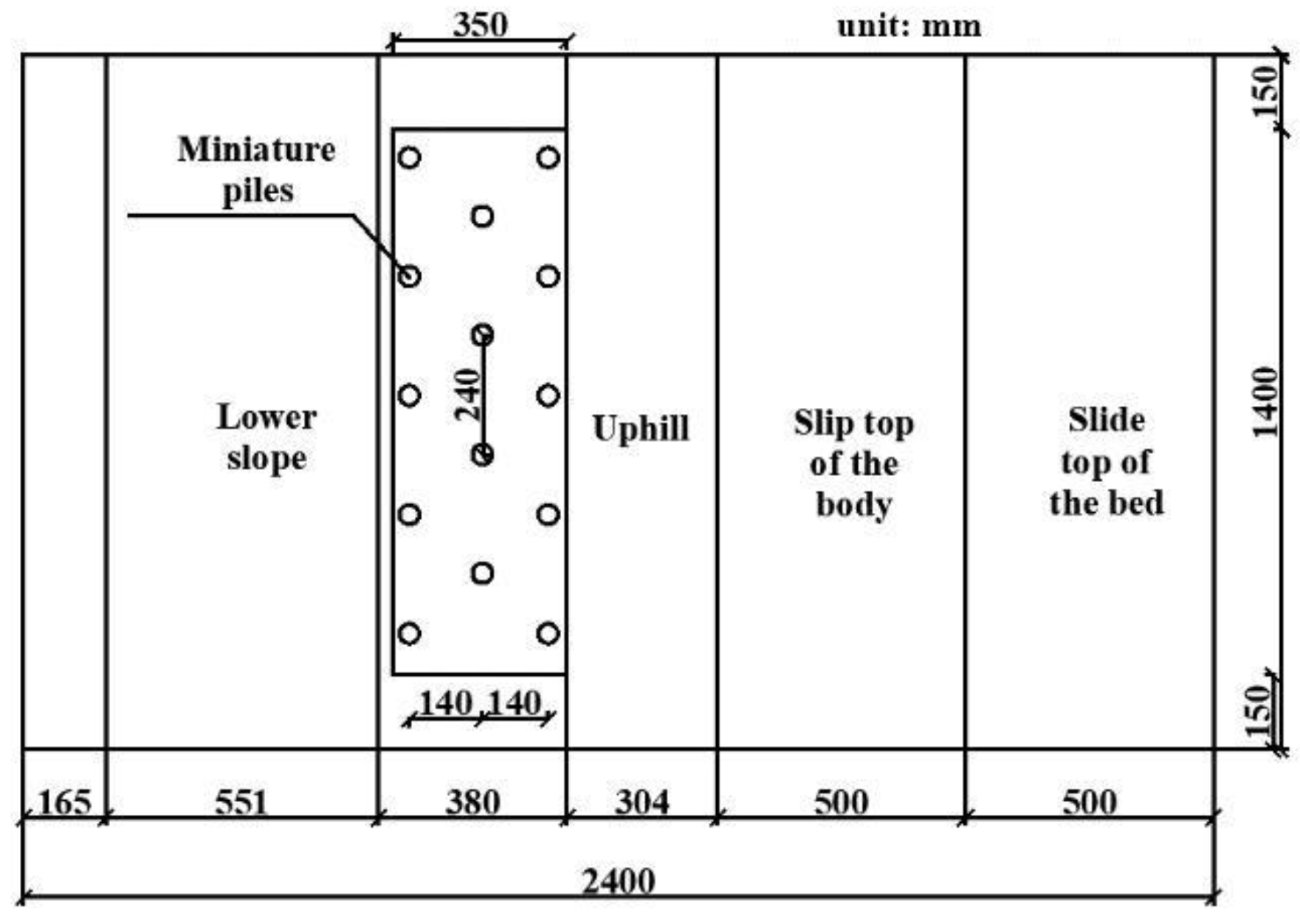






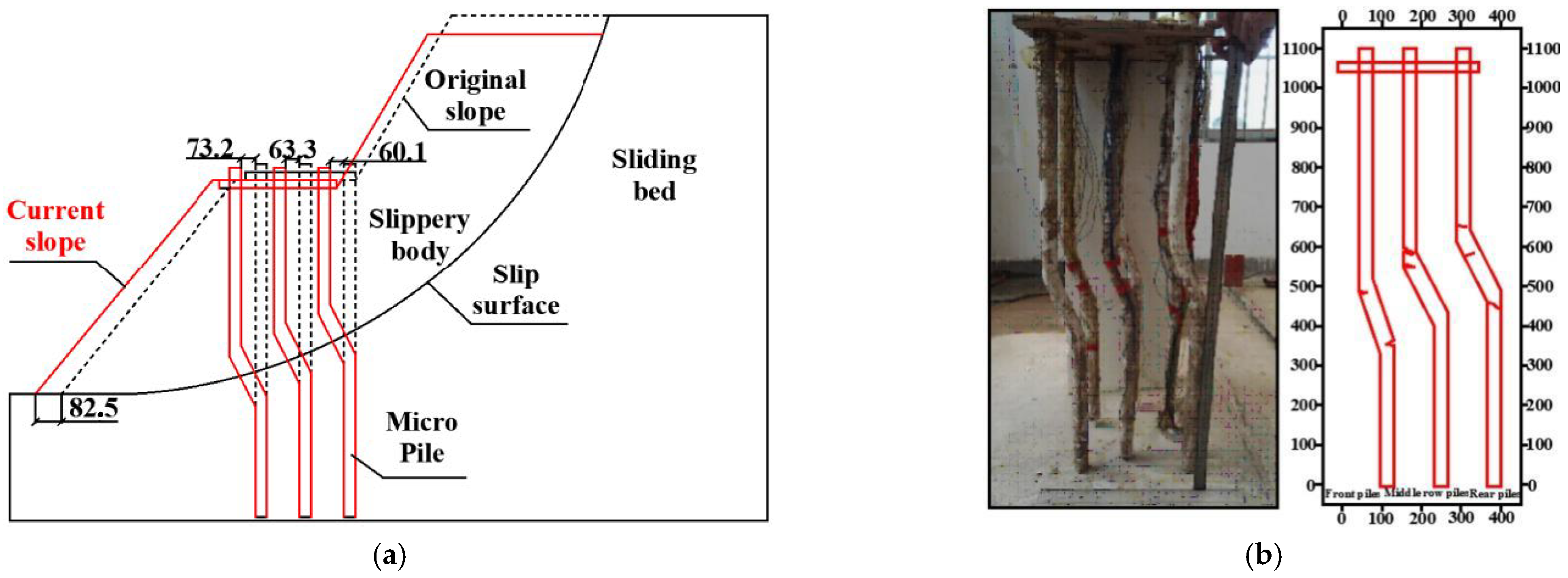


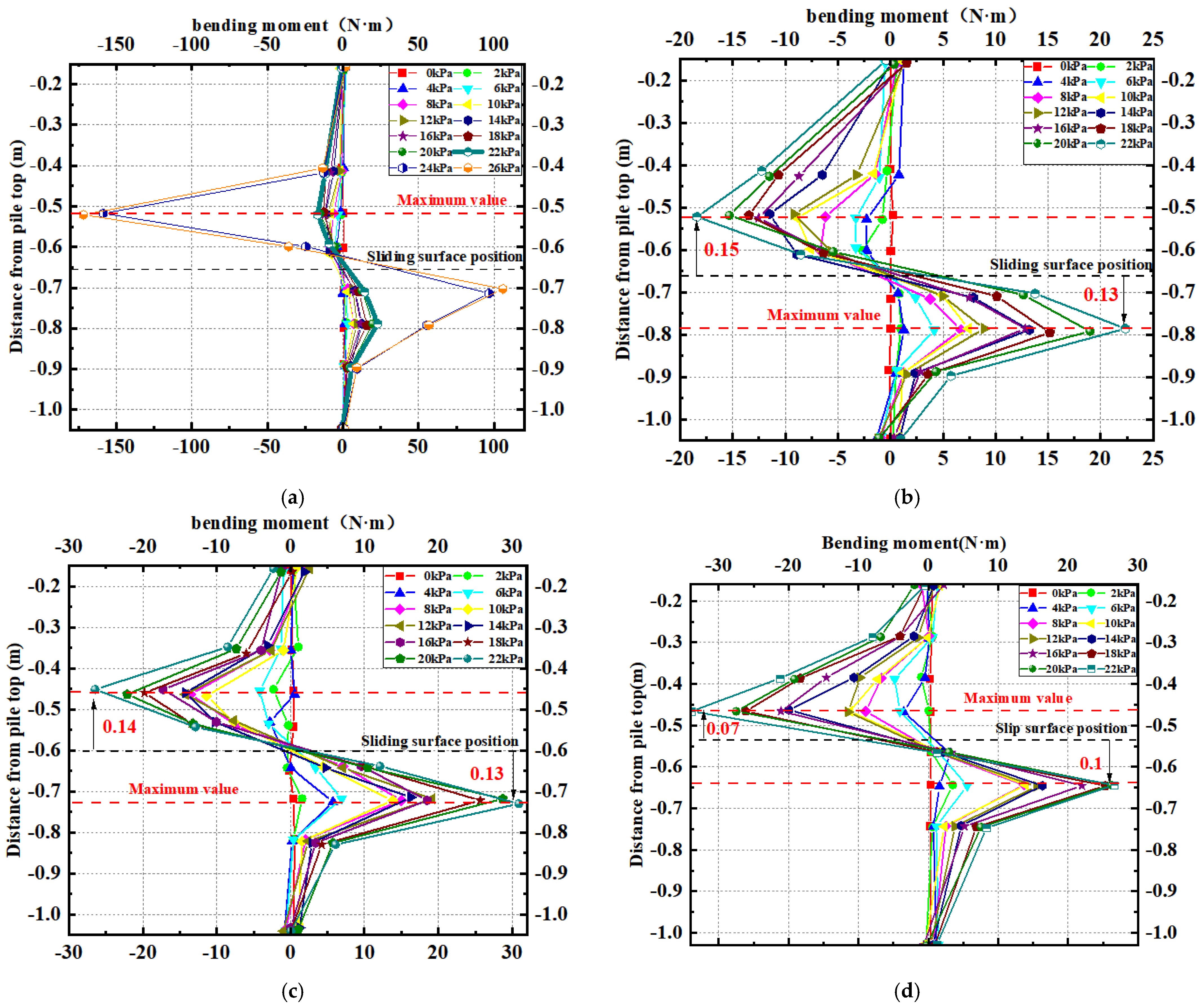
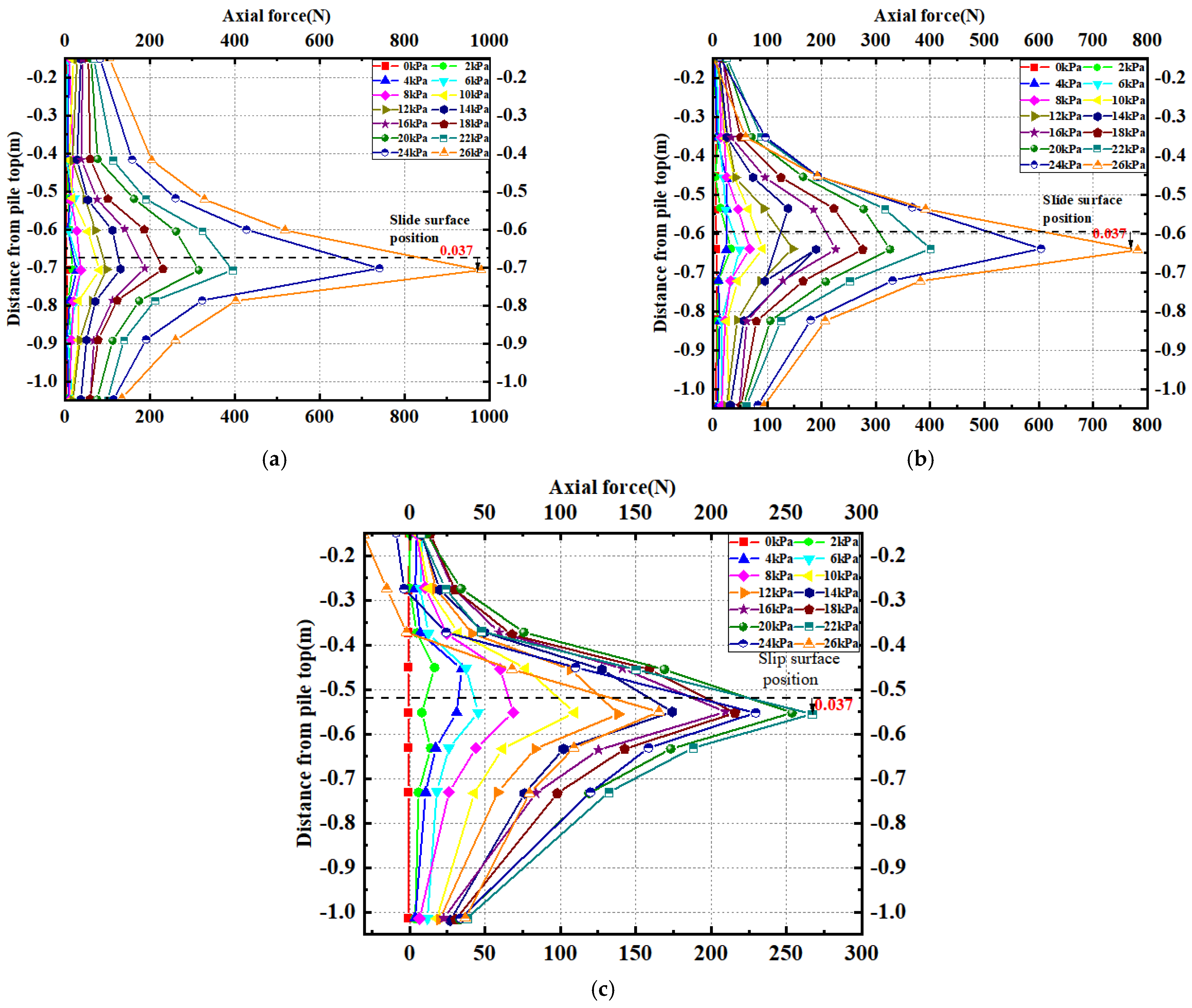


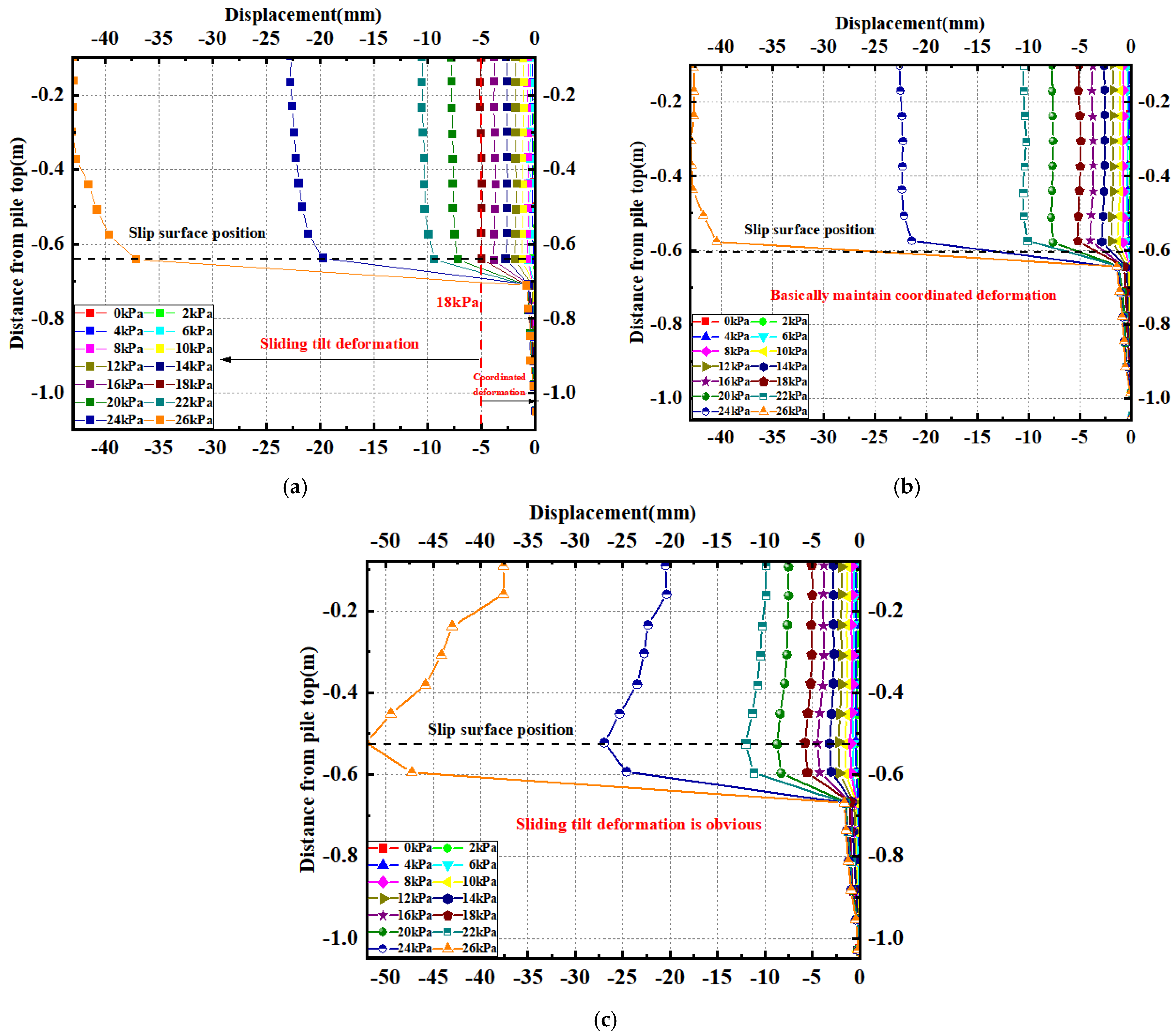
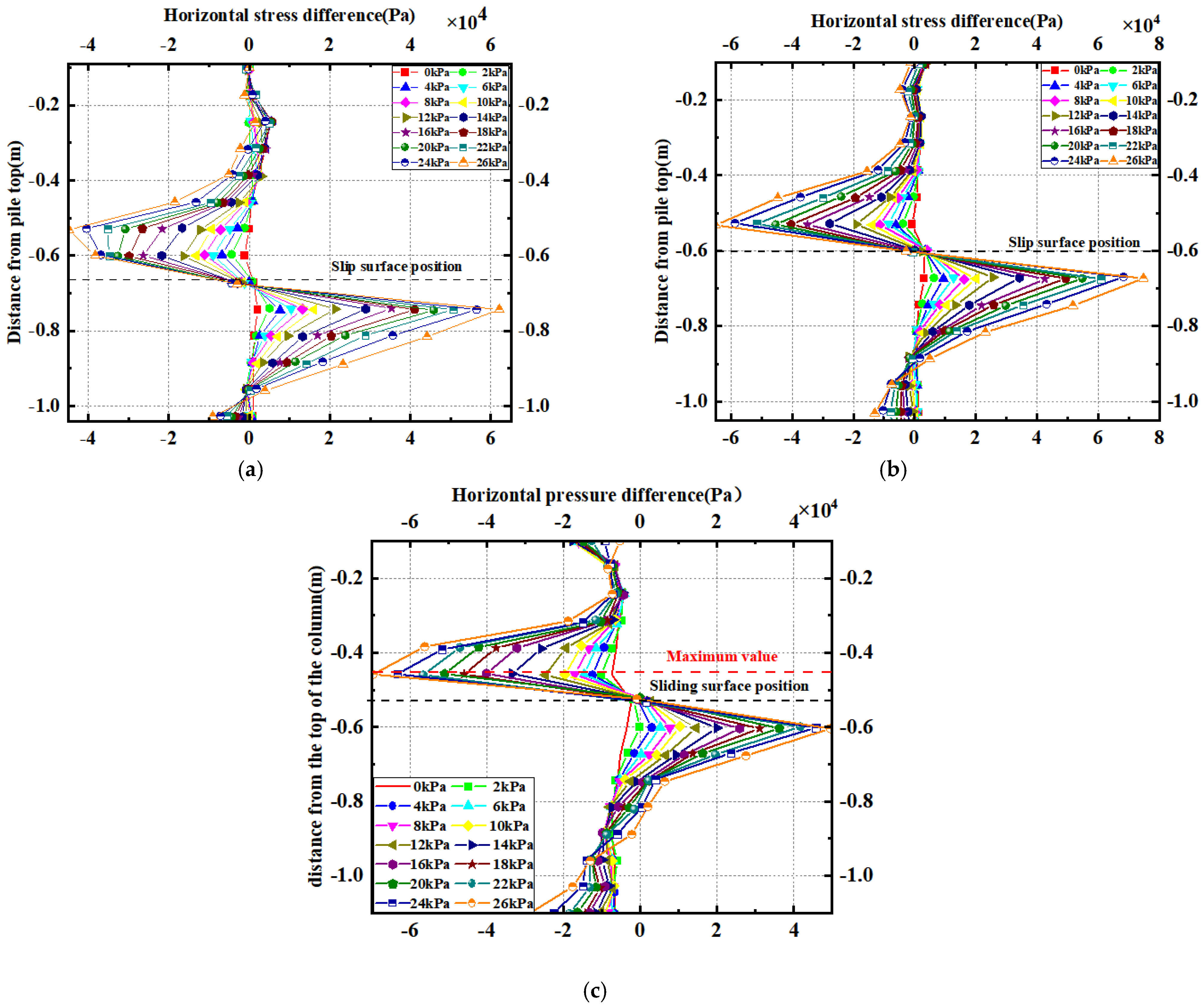

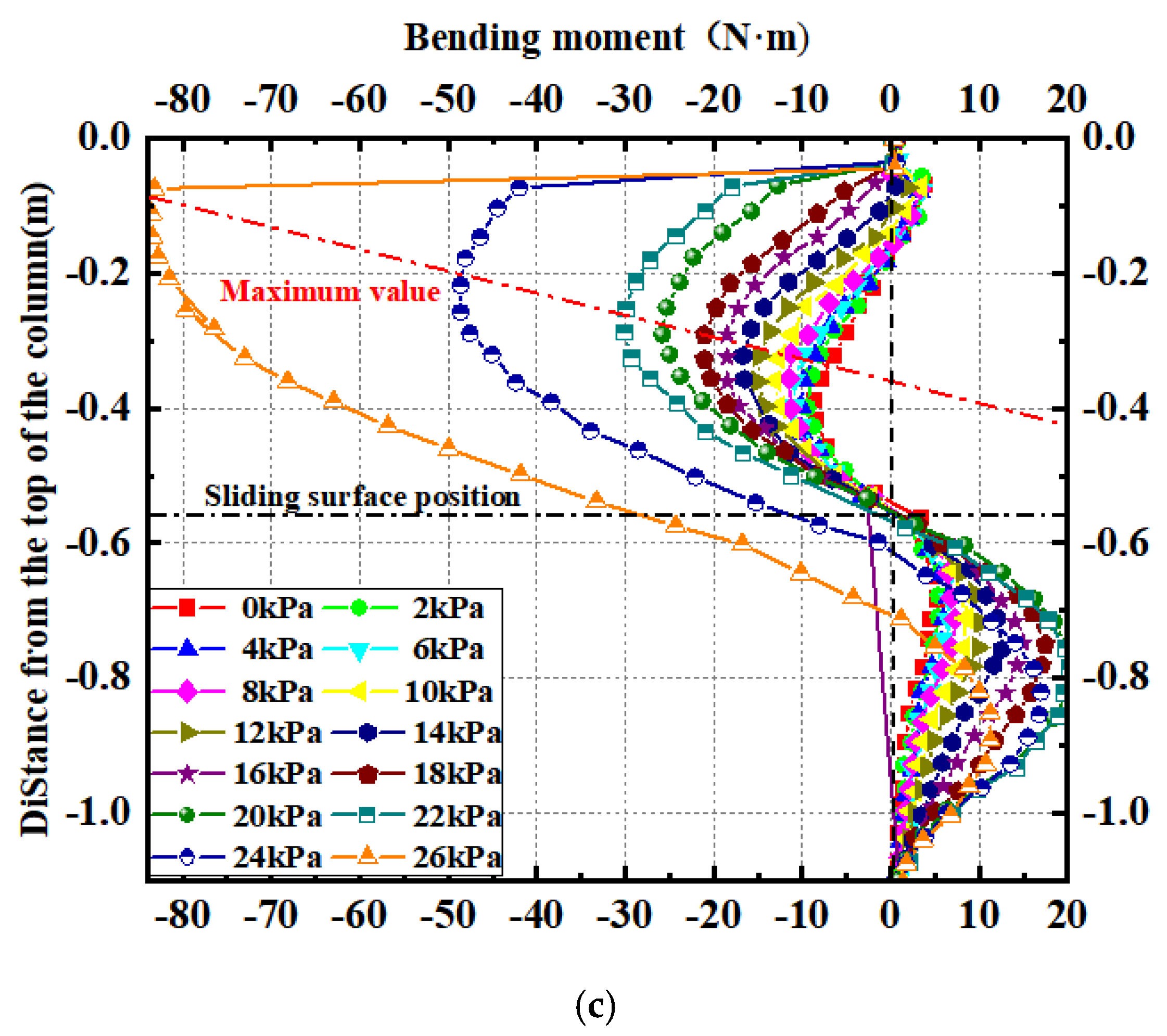

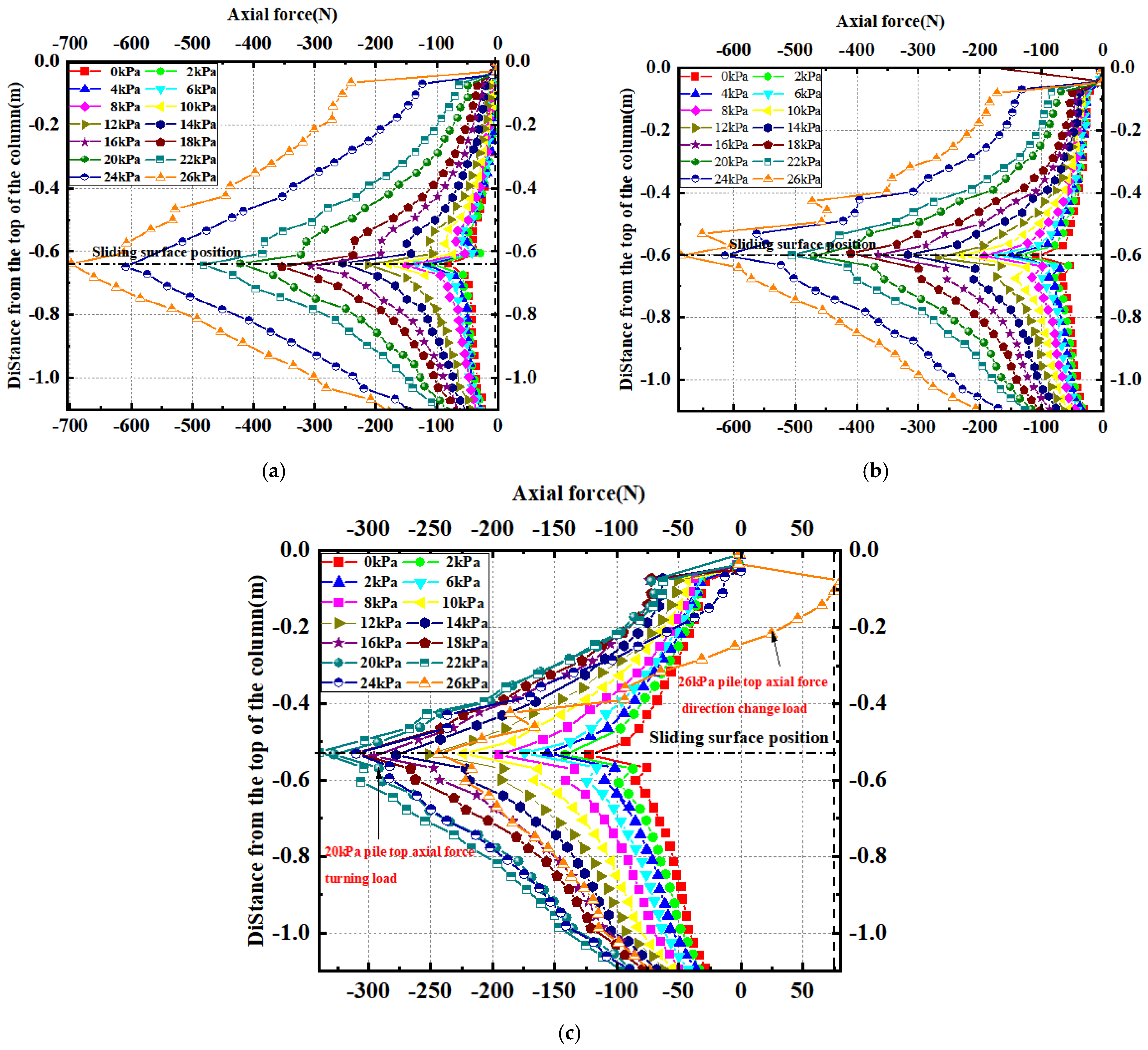
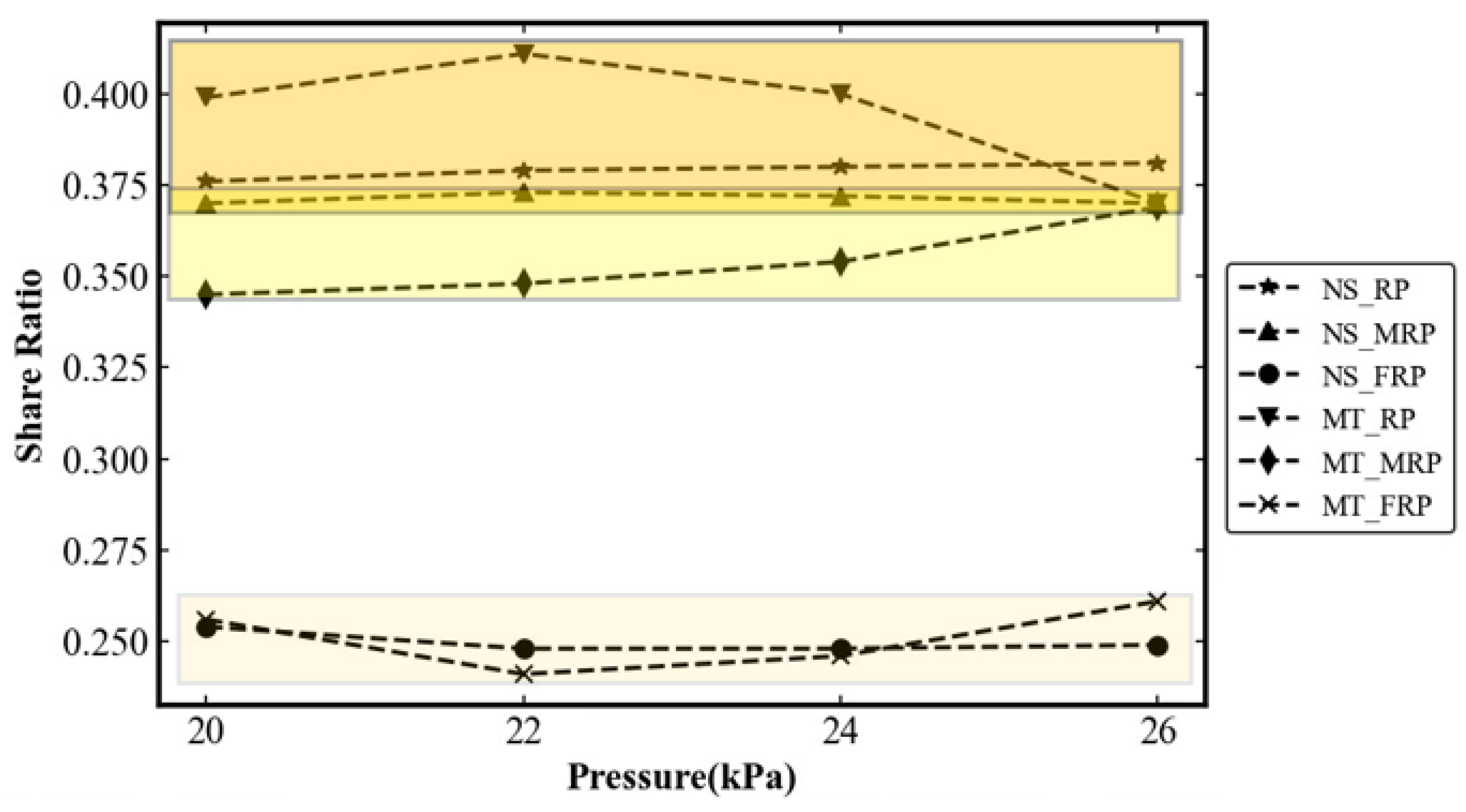

| Physical Quantity | Similar Ratio Representation | Dimension | Similarities | Similarity Factor | Remarks |
|---|---|---|---|---|---|
| Geometric dimensions L | 8 | Basic Quantities | |||
| Modulus of elasticity E | 3 | Basic Quantities | |||
| Density ρ | 0.75 | Basic Quantities | |||
| Load F | 192 | ||||
| Stress σ | 3 | ||||
| Strain ε | 1 | ||||
| Flexural stiffness EI | 12,288 | ||||
| Poisson’s ratio μ | 1 | ||||
| Angle of internal friction φ | 1 | ||||
| Time T | 4 | ||||
| Vibration frequency f | 0.25 | ||||
| Speed v | 2 | ||||
| Acceleration a | 0.5 | ||||
| Damping factor c | 96 | ||||
| Quality M | 384 | ||||
| Stiffness K | 24 |
| Material Name | Weight Capacity γ (kN·m−3) | Water Content ρ (%) | Cohesion c (kPa) | Angle of Internal Friction φ (°) | Modulus of Elasticity E (kPa) |
|---|---|---|---|---|---|
| Model earth | 22.5 | 12.1 | 18.4 | 25.2 | 2.5 × 104 |
| Loading Location | 20 kPa | 22 kPa | 24 kPa | 26 kPa | ||||
|---|---|---|---|---|---|---|---|---|
| Differential Earth Pressure (kPa) | Proportion | Differential Earth Pressure (kPa) | Proportion | Differential Earth Pressure (kPa) | Proportion | Differential Earth Pressure (kPa) | Proportion | |
| Rear-row piles | 47.15 | 0.399 | 55.55 | 0.411 | 58.22 | 0.400 | 59.04 | 0.370 |
| Middle-row piles | 40.66 | 0.345 | 47.05 | 0.348 | 51.61 | 0.354 | 58.84 | 0.369 |
| Front-row piles | 30.24 | 0.256 | 32.68 | 0.241 | 35.85 | 0.246 | 41.70 | 0.261 |
| Total | 118.05 | 1 | 135.27 | 1 | 145.68 | 1 | 159.58 | 1 |
| Material Parameters | Weight Capacity γ (kN/m3) | Modulus of Elasticity E (MPa) | Poisson’s Ratio μ | Cohesion c (kPa) | Angle of Internal Friction φ (°) | Tensile Strength T (Pa) |
|---|---|---|---|---|---|---|
| Soil body | 19.0 | 30.0 | 0.3 | 12.0 | 30.0 | 0 |
| Sliding surface | - | - | - | 0 | 26.8 | - |
| Structure Type | Cross-Sectional Dimensions (m) | Density (g/cm3) | Modulus of Elasticity (E/GP) | Poisson’s Ratio μ | Polar Moment of Inertia (m4) | Y-Axis Moment of Inertia (m4) | Z-Axis Moment of Inertia (m4) |
|---|---|---|---|---|---|---|---|
| Micropile | φ 0.036 | 1200 | 11.67 | 0.25 | 1.473 × 10−7 | 7.366 × 10−8 | 7.366 × 10−8 |
| Connecting beam | 1.1 × 0.35 × 0.02 | 700 | 0.45 | 0.5 | - | - | - |
| Loading Location | 20 kPa | 22 kPa | 24 kPa | 26 kPa | ||||
|---|---|---|---|---|---|---|---|---|
| Differential Earth Pressure (Pa) | Proportion | Differential Earth Pressure (Pa) | Proportion | Differential Earth Pressure (Pa) | Proportion | Differential Earth Pressure (Pa) | Proportion | |
| Rear-row piles | 48,467.9 | 0.376 | 54,409.8 | 0.379 | 61,795.9 | 0.380 | 68,939.9 | 0.381 |
| Middle-row piles | 47,664.3 | 0.370 | 53,603.4 | 0.373 | 60,539.1 | 0.372 | 66,922.7 | 0.370 |
| Front-row piles | 32,774.2 | 0.254 | 35,532.2 | 0.248 | 40,488.8 | 0.248 | 44,966.7 | 0.249 |
| Total | 128,906.4 | 1 | 143,545.4 | 1 | 162,823.8 | 1 | 1,880,829.3 | 1 |
Disclaimer/Publisher’s Note: The statements, opinions and data contained in all publications are solely those of the individual author(s) and contributor(s) and not of MDPI and/or the editor(s). MDPI and/or the editor(s) disclaim responsibility for any injury to people or property resulting from any ideas, methods, instructions or products referred to in the content. |
© 2023 by the authors. Licensee MDPI, Basel, Switzerland. This article is an open access article distributed under the terms and conditions of the Creative Commons Attribution (CC BY) license (https://creativecommons.org/licenses/by/4.0/).
Share and Cite
Xu, R.; Sui, G.; Wang, G.; Cheng, H.; Li, X.; Yang, W.; Deng, J.; Zeng, F. Study on the Interaction Mechanism between Micropiles and Soil Landslides. Sustainability 2023, 15, 10630. https://doi.org/10.3390/su151310630
Xu R, Sui G, Wang G, Cheng H, Li X, Yang W, Deng J, Zeng F. Study on the Interaction Mechanism between Micropiles and Soil Landslides. Sustainability. 2023; 15(13):10630. https://doi.org/10.3390/su151310630
Chicago/Turabian StyleXu, Rui, Guochen Sui, Guanglu Wang, Hui Cheng, Xunchang Li, Wei Yang, Juntao Deng, and Farong Zeng. 2023. "Study on the Interaction Mechanism between Micropiles and Soil Landslides" Sustainability 15, no. 13: 10630. https://doi.org/10.3390/su151310630







